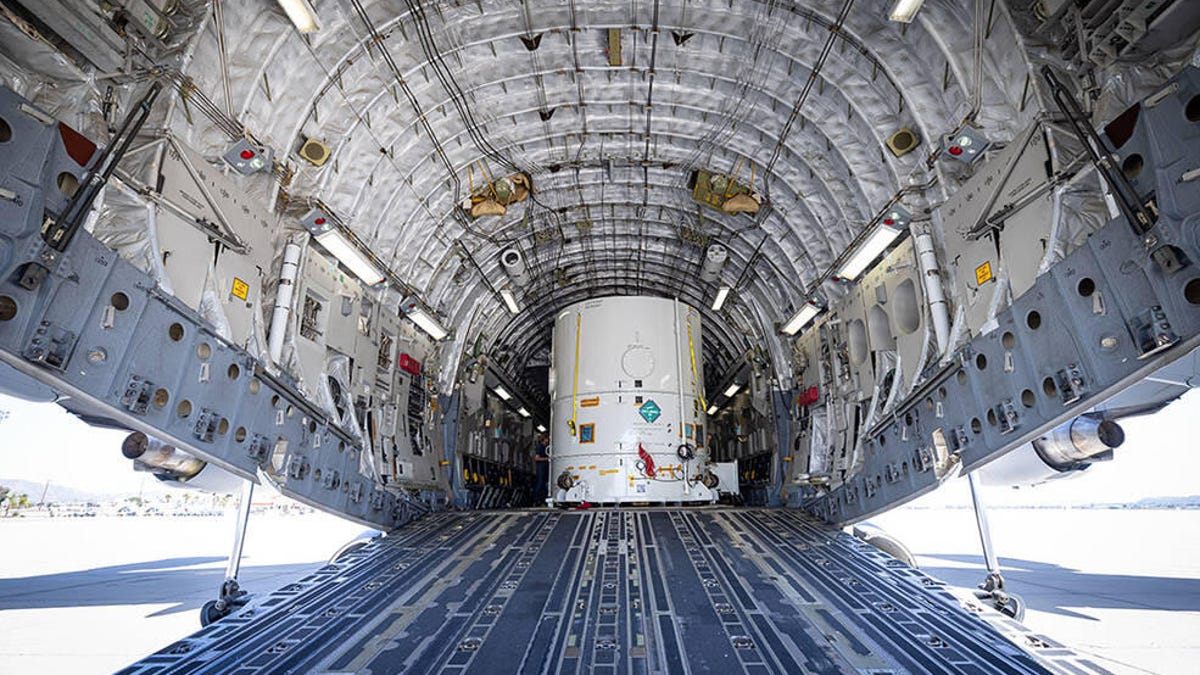See NASA's Massive New Spacecraft Built to Hunt for Extraterrestrial Life

The main body of NASA's Europa Clipper spacecraft is seen in its shipping container.
What's happening
NASA has completed building the main body of the Europa Clipper spacecraft.
Why it matters
It's a massive device that'll be programmed to fly by and investigate Jupiter's icy moon Europa, a foreign world that scientists think could host extraterrestrial life.
It's an aluminum cylinder about the size of an SUV. It stands about as high as a regulation basketball hoop and will have solar arrays that, when extended, would fill an entire basketball court. It's the largest NASA spacecraft ever developed for a planetary mission, and in October 2024, it's scheduled to voyage toward an extraterrestrial world many scientists deeply believe could host alien life.
It's named the Clipper, and it's bound for Jupiter's icy moon Europa.
On Tuesday, NASA released a few long-awaited images of the Clipper's completed main body, calling this a "huge milestone" for the ambitious mission.
Engineers and technicians inspect the main body of NASA's Europa Clipper spacecraft.
"This delivery brings us one step closer to launch and the Europa Clipper science investigation," Jordan Evans, mission project manager at NASA's Jet Propulsion Laboratory, said in a statement.
Further feeding the excitement, the agency even shared a mesmerizing time-lapse video of the Clipper being transported from its birthplace at the Johns Hopkins Applied Physics Laboratory to the snowy-white clean rooms of of NASA's Jet Propulsion Laboratory.
You can clearly see the massive device brilliantly unveiled for the first time, locking in place for the next step of its highly anticipated journey.
Why does Europa lead the quest to find aliens?
The smallest of Jupiter's four Galilean moons, Europa is an extremely talked-about world in the science community.
It's simply because study after study continues to offer evidence that this frigid floating sphere has ultra-promising conditions to support life. Alien life.
Experts have found the companion of Jupiter, which is about 90% the size of our own moon, to have signs of just the right chemical elements, such as carbon and hydrogen, to host living beings. Plus, they've collected a wealth of concrete proof that Europa has a significant amount of water -- about twice as much as all of Earth's oceans combined.
This NASA illustration shows what the Europa Clipper will look like at the icy moon with Jupiter in the background, all solar arrays extended.
If they're there, according to NASA, Europa life forms could range from microbes to more complex beings. But nonetheless, the agency emphasizes that it's quite reasonable to conclude that something intriguing lurks on this orb. And it's probably alive.
Together, that's where the Europa hype stems from -- and, where Clipper's mission is rooted.
What will NASA's Clipper spacecraft do?
Once completed, Clipper will be embedded with nine science instruments poised to gather data on Europa's atmosphere, surface and interior.
It's going to take something like six years for Clipper to make the 1.8 billion-mile (2.9 billion-kilometer) journey to the foreign moon, but once it's there, it'll begin investigating the secrets of Europa.
Europa Clipper's thermal imager shown in a clean room at JPL.
NASA says that while using its 24 precision engines to conduct nearly 50 flybys of the moon, Clipper will gather information to tell scientists what the depth and salt-capacity of Europa's oceans are like, as well as the thickness of the orb's ice crust. It'll possibly even shed light on whether there really are vents on the moon's surface that blow subsurface water into space.
In fact, some of these instruments have already arrived at JPL, ready to be mounted on the spacecraft.
We have the Europa-UVS, for instance, which is an ultraviolet spectrograph, and another called E-Themis, a thermal emission imaging instrument. The latter one is a big one. It's the device that can map the moon's temperatures and decode exactly where all the alleged Europa water is.
Europa Clipper's ultraviolet spectrograph, called Europa-UVS. It's the gray and silver metal box on the upper right of the nadir deck.
Though right now NASA says it's continuing to work on the main module at JPL to make sure all T's are crossed and I's are dotted. "What arrived at JPL represents essentially an assembly phase unto itself. Under APL's leadership, this delivery includes work by that institution and two NASA centers," Evans said. "Now the team will take the system to an even higher level of integration."
The bulk of the work will likely be finished by the end of 2022, the team said, and if everyone's right about the glory of Europa, we might very well have the first evidence of alien life in 2031.
In a 2020 outline of the Clipper mission, NASA straightforwardly said, "We are on the cusp of exploring what may be the best place in our solar system to look for life beyond Earth.
"That place is Jupiter's moon Europa."

